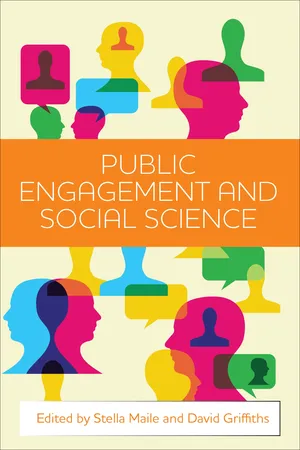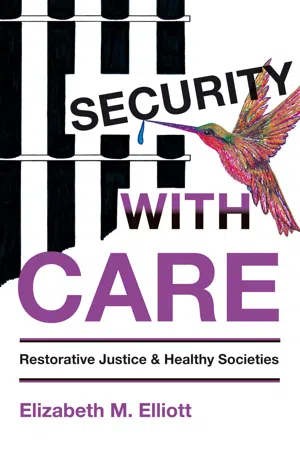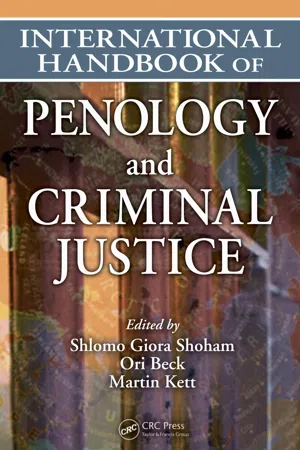Psychology
Anger Management and Restorative Justice Programmes
Anger management and restorative justice programs are interventions designed to help individuals manage and express their anger in healthier ways, as well as to restore relationships and address harm caused by conflict. These programs often involve teaching communication and conflict resolution skills, promoting empathy and understanding, and providing opportunities for individuals to take responsibility for their actions and make amends.
Written by Perlego with AI-assistance
Related key terms
1 of 5
8 Key excerpts on "Anger Management and Restorative Justice Programmes"
- Phil Gorman(Author)
- 2020(Publication Date)
- Routledge(Publisher)
Possible answer: Anger management is a form of cognitive behavioural therapy that attempts to deal with the negative thoughts and behaviour that arise from faulty cognition and then replace that with more appropriate thoughts and behaviour. There are three stages of anger management.The first stage is cognitive preparation in which the therapist would talk through the situations that the individual finds anger provoking and the pattern that their particular thoughts and behaviour would go through when faced with these situations.The second stage is skill acquisition and rehearsal in which the focus is on the offender learning the skills that will prevent them from simply attacking someone. One important skill in this process is learning to use self-talk as a way of taking control that could be used in anger-provoking situations. They might also learn relaxation techniques, which they could use when faced with anger-provoking situations.The third stage is practice and application in which the offender would be encouraged to practice their new skills in a series of situations that would gradually become more provocative based on a hierarchy that would have been previously prepared by the offender themselves. This would allow for the offender to change their behaviour in real situations.Restorative justice is based on the notion of community service that has existed in some form since the 1970s in the UK. The idea of community service is that it should be practical, rehabilitative and functional, in that it would be less costly, involving the offender giving back something to society and also create real communication between the offender and the rest of society. These principles have been developed further in the use of restorative justice.- No longer available |Learn more
- (Author)
- 2014(Publication Date)
- The English Press(Publisher)
________________________ WORLD TECHNOLOGIES ________________________ Chapter-4 Anger Management The term anger management commonly refers to a system of psychological therapeutic techniques and exercises by which someone with excessive or uncontrollable anger can control or reduce the triggers, degrees, and effects of an angered emotional state. In some countries, courses in anger management may be mandated by their legal system. One technique for controlling anger is finding agreement with another person rather than conflict. The use of deep breathing and meditation can be used as a means of relaxation. Other interventions include learning empathy, stress management skills, forgiveness, changing how you speak about yourself or others and improving optimism. As the issue of anger varies from person to person, the treatments are designed to be personal to the individual. Methods of anger management Psychologists recommend a balanced approach to anger, which both controls the emotion and allows the emotion to express itself in a healthy way. Some descriptions of actions of anger management are: • Direct This would include making behavior visible and making communication clear. The end result is to not become resentful, but rather, be honest about the feeling of anger and what is causing it. • Honorable This includes identifying the moral basis for the anger, and being willing to dialog around the reason for the anger. In short, this includes taking responsibility for actions. • Focused This means staying with the issue of concern, and not bringing up irrelevant material. • Courageous This implies careful and thoughtful self-examination. Additionally, this means being willing to admit when one is wrong or when a reaction is inappropriate. • Humility This means seeking the truth instead of merely being defensive, and self-justifying. - eBook - PDF
Offending Behaviour Programmes
Development, Application and Controversies
- Emma J. Palmer, Clive R. Hollin(Authors)
- 2006(Publication Date)
- Wiley(Publisher)
Other elements include time out and relaxation train-ing, recognising anger-inducing thinking, coping self-talk for provoking events, assertiveness, conflict resolution, and relationship skills (Howells et al., 2001). The most important application issue with such stand-alone programmes con-cerns participant selection. Howells has noted that stress-inoculation-based anger management is not the treatment of choice: (a) when the violence arises from over-controlled rather than under-controlled anger, (b) when the violence has “a more instrumental and sadistic quality” (p. 172), such as in psychopaths, and (c) when violent behaviour occurs in the service of either immediate or both immediate and long-term goals (Howells, 1989). The violence of serious violent offenders com-monly shares characteristics with both (b) and (c) above. Furthermore the pro-grammes are typically of low-intensity. Together these factors suggest that stand-alone anger management will rarely be the treatment of choice for these men. Multi-modal Programmes Multi-modal programmes are generally more intensive. For example, the Correc-tional Service of Canada’s Persistently Violent Offender treatment programme, comprises about 240 hours of mainly group sessions over 16 weeks (Serin, Preston & Murphy, 2001). The main referral criterion is a documented history of at least three separate violent acts. The programme has three distinct components. First is a motivational intervention that socialises offenders into programme requirements and group processes, and develops expectations of change. Second, participants develop a comprehensive socio-cognitive model of their risk factors for violence. Third, they are taught skills that are to serve as pro-social alternatives to violence, including managing affective arousal, cognitive restructuring, problem-solving, assertiveness, conflict resolution, altering lifestyle risk factors, and increasing self-control. - eBook - ePub
Working With Offenders
A Guide to Concepts and Practices
- Rob White, Hannah Graham(Authors)
- 2013(Publication Date)
- Willan(Publisher)
Anger management is a common component of offender rehabilitation. There are a diversity of programs, from focused individual interventions addressing specific offending behaviour or personal characteristics and beliefs, through to general group programs offered to address common causes or roots of anger and aggression. Most anger management therapies are influenced by, if not entirely based on, principles of cognitive behavioural therapy and the stages of change model.There are four main categories of intervention that are used alongside each other to identify and address the underlying issues of anger (Reilly and Shopshire 2002: 1):- Relaxation interventions which target emotional and physiological components of anger and any associated anxiety.
- Cognitive interventions which target cognitive processes such as hostile appraisals and attributions, irrational beliefs, and inflammatory thinking.
- Communication skills interventions which target deficits in assertiveness and conflict resolution skills.
- Combined interventions which integrate two or more cognitive behavioural therapy interventions and target multiple response domains.
Evidence and EfficacyIn general, research has shown that anger management interventions have moderate to strong efficacy (Del Vecchio and O’Leary 2004). One study found that CBT-based anger management interventions were 76 per cent more effective, compared to those who received nothing, when used with people with complex needs, like mental health and substance dependency (Reilly and Shopshire 2002). However, there are some researchers who have highlighted concerns about limited efficacy of anger management interventions in the rehabilitation of serious violent offenders (Howells et al - eBook - PDF
- Maile, Stella, Griffiths, David(Authors)
- 2014(Publication Date)
- Policy Press(Publisher)
Restorative justice One approach to offender reintegration and the continued education of communities around the realities of offenders and offending is restorative justice; which seems to align, in part anyway, to some of the current Coalition government’s ideas around the ‘big society’. Restorative justice, according to Zehr (1990), is the notion that crime is a violation of both individuals and society; therefore, there are obligations for the victim, offender and the community to work together to achieve solutions that promote repair, reconciliation and reassurance. With this in mind, a number of definitions have been created to try and pin down what restorative justice actually is. Restorative justice is by no means a contemporary form of ‘crime control’, and, in fact, was the dominant model of criminal justice until the Norman Conquest of Europe at the end of the Dark Ages (Weitekamp, 1999). However, as Harding (1992) and Schafer (1970) point out, from the end of the 12th century, a crime was no longer committed against an individual, but against the state, which is how it remained until the Crime and Disorder Act 1998 and theYouth Justice and Criminal Evidence Act 1999. Although restorative measures are often seen as an alternative to punishment, Daly (2001) argues that restorative sanctions and processes should be seen as ‘alternative punishments’ rather than ‘alternatives to punishment’. Restorative justice offers a new paradigm of justice as it does not define the ‘state’ as the victim, but works on the axiom that criminal behaviour is a conflict between individuals. Restorative justice places the offender and the victim at the centre of the system in active problem-solving roles (Umbreit, 1994). Daly (2001) felt that all hard burdens imposed and accepted under pressure, as with most restorative interventions in England and Wales, should be considered - eBook - PDF
Security, With Care
Restorative Justice and Healthy Societies
- Elizabeth M. Elliott(Author)
- 2020(Publication Date)
- Fernwood Publishing(Publisher)
The first of these, shame, was a foundational concept in one of the first theoretical offerings in the field, Braithwaite’s Crime, Shame and Reintegration (1989), and continues to provoke discussion and debate. The second area is that of trauma, raised more recently by restorative practitioners working with cases of serious crime and violence (Gustafson 2005), which is the main topic of Chapter 9. Although emerging primarily in the arena of restorative justice, both psychological phenomena also hold enormous implications for retributive-adversarial justice processes. Emotions and Criminal Justice In his classic study of the history of manners, the civilizing process and the formation of states, Norbert Elias warns that investigations of human behav- iour that focus on reason at the expense of emotion will be of limited value (1994 [1939]: 486). Since the 1980s, the concept of “emotional intelligence” has seeped into human science discourses, although criminology has been notably resilient in deflecting most potential incursions of theoretical atten- tion to emotions. When attention to emotion is evident in criminal justice or national security endeavours, it is manifested in odd and distorted ways. In Canada, for example, federal correctional programs address emotions in prisoner behaviour, 1 although the emotional contexts in which these programs occur and the personal emotional health of individual correctional employ- ees remain well out of focus. In the U.S., political obsession with a “war on terror” essentially amounts to war on an emotional affect, 2 a rather dubious military target by any standards. The broad capture and dutiful embrace of science and reason in criminological research and criminal justice institutions appear to have stunted any development of interest in emotions, with curious implications. As Sherman notes, “For three centuries, criminology has tried to make reason, rather than emotion, the primary method of justice. - eBook - PDF
Helping Schoolchildren Cope with Anger
A Cognitive-Behavioral Intervention
- Jim Larson, John E. Lochman(Authors)
- 2010(Publication Date)
- The Guilford Press(Publisher)
25 CHAPTER 3 The Role of Anger Management Training in a Comprehensive School Program of Positive Behavioral Supports This is a book about helping children manage anger-fueled aggressive and disruptive behav- ior through the use of small-group or individual cognitive-behavioral skills training. There is a percentage of children in every school building for whom the traditional disciplinary system is, in large measure, ineffective. To the adults in charge, these are students who appear to be aware of the rules of conduct but who are seemingly unable (or, in fewer cases, unwilling) to adhere to them. They defy adult compliance requests, sometimes with angry retorts or tantrums. • They argue, push, and fight on the playground, in the hallways, and in the cafeteria. • They disrupt classroom cooperative learning groups and are routinely feared and • rejected by peers. As a consequence, these students take up a disproportionate amount of teachers’ and administrators’ time. They become subjected to a punishment-oriented school disciplinary system that is ill designed to meet their needs (Kaufman, 2005) and that becomes increas- ingly exclusionary over time (Skiba & Peterson, 2000). The traditional school disciplinary system is typically organized to respond to problem behavior with aversive consequences— a phone call home, a stern lecture by the administrator, after-school detention, in-house suspension, and the like. This system is built on the proposition that most children who engage in problem behavior actually know how to behave appropriately but, through acci- dent or design, have chosen not to and therefore deserve a mild punitive consequence to help remind them in the future. Portions of this chapter were adapted from Larson (2005). Copyright 2005 by The Guilford Press. Adapted by per- mission. - Shlomo Giora Shoham, Ori Beck, Martin Kett(Authors)
- 2007(Publication Date)
- Routledge(Publisher)
Procedural justice theory and its research show that “clients” of the police and justice system are more concerned with the way they have been treated than with the outcome of the procedure (Tyler and Huo 2001). Being treated with respect and equity, being taken seriously, being listened to are crucial for citizens’ beliefs in the system’s legitimacy, in both victims and offenders. “The manners and emo-tional overtones of justice officials affect future offending rates as much [as] or more than the formal decisions and severity of punishment” (Sherman 2003). The characteristics of a restorative justice meeting probably offer better conditions for the stakeholders to feel such procedural justice than traditional court proceedings. Braithwaite’s theory on reintegrative shaming has been fundamental in developing insight into what happens emotionally in a restorative justice process (1989). The theory suggests that shame in the offender for the offense committed is a crucial emotion for his or her further conduct. If the shaming is stigmatizing, as in most court interventions, the risk is psychosocial iden-tification with nonconformism and further offending. If, on the contrary, shaming is focused on the behavior and not on the person, and is followed by gestures of reacceptance, it is a powerful emotion to provoke desistance from reoffending. This theoretical approach has been predominant in explaining restorative processes, especially conferencing (Braithwaite and Mugford 1994). Since then, the centrality of the shame emotion is increas-ingly being nuanced and completed by emotions like guilt, remorse, empathy, and others (Walgrave and Aertsen 1996; Morris 2002; Karstedt 2002; van Stokkom 2002). Moreover, reintegrative shaming only tries to explain what Restorative Justice: An Alternative for Responding to Crime? 639 happens to the offender, whereas restorative processes are focused at least as much on the emotional and other benefits for the victim.
Index pages curate the most relevant extracts from our library of academic textbooks. They’ve been created using an in-house natural language model (NLM), each adding context and meaning to key research topics.







